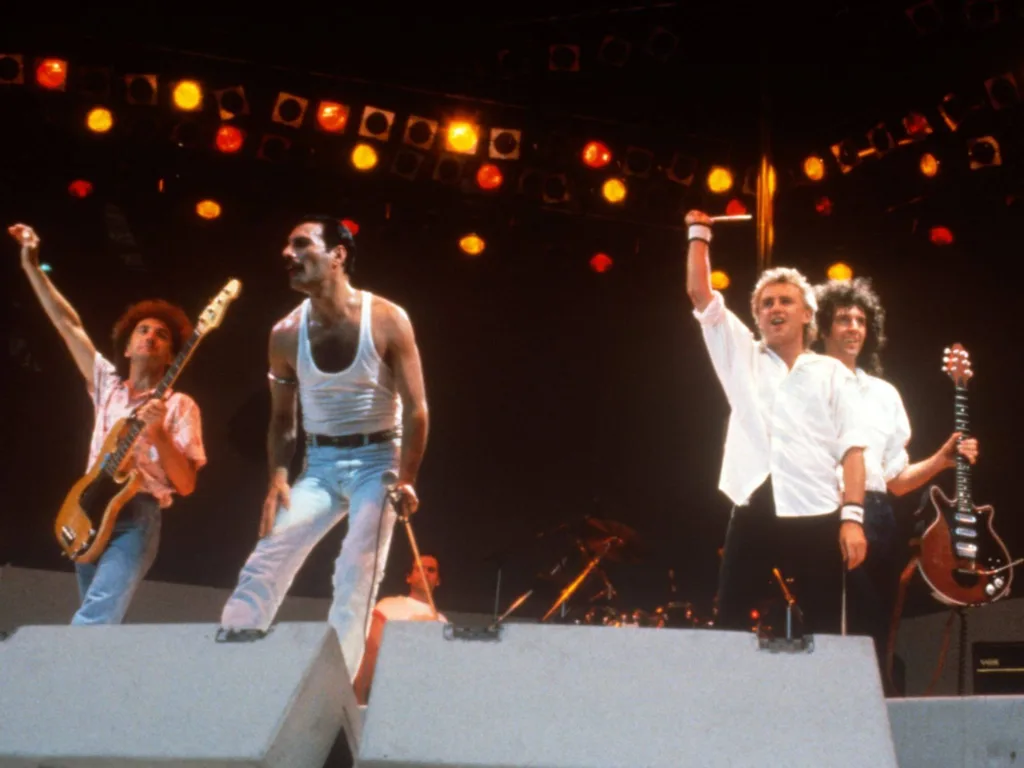Live Aid was a historic event that took place on July 13, 1985. It was organized by Bob Geldof and Midge Ure to raise funds for famine relief in Ethiopia. The event was broadcast globally and featured some of the biggest names in music, all coming together for a noble cause.
The lineup for Live Aid was diverse and featured artists from different genres. The event had two main stages, one at Wembley Stadium in London, England, and the oter at JFK Stadium in Philadelphia, USA. The performances were broadcast live to an estimated audience of 1.9 billion people across 150 countries.
The London stage kicked off with an energetic performance by Status Quo, followed by the likes of The Style Council, The Boomtown Rats, and Adam Ant. The stage then saw performances from some of the biggest names in rock and pop music, including U2, Dire Straits, Phil Collins, and Queen.
Queen’s performance at Live Aid has gone down in history as one of the greatest live performances of all time. The band played a six-song set, including “Bohemian Rhapsody,” “Radio Ga Ga,” and “We Are the Champions.” The energy and showmanship of Freddie Mercury made the performance unforgettable.
David Bowie followed Queen’s performance, delivering a set that included “Heroes” and “Rebel Rebel.” Other notable performances on the London stage included Madonna, Elton John, and The Who.
The Philadelphia stage featured performances from some of the biggest names in American music, including Tom Petty and the Heartbreakers, The Four Tops, and Bob Dylan. The stage also saw performances from some of the biggest names in rock, including Led Zeppelin’s reunion performance, Black Sabbath, and Judas Priest.
Live Aid was not just about the big names, however. The event also featured lesser-known artists who used the platform to showcase their talents and reach a wider audience. The event also featured collaborations between artists, such as Mick Jagger and Tina Turner’s performance of “State of Shock.”
The Live Aid lineup was diverse and featured some of the biggest names in music. The event showcased the power of music to bring people together and raise awareness for a noble cause. The performances were unforgettable and have gone down in history as some of the greatest live performances of all time.
Who Turned Down Live Aid?
The supergroup The Highwaymen, consisting of Johnny Cash, Waylon Jennings, Willie Nelson and Kris Kristofferson, did not appear at Live Aid. It is important to note that their debut album was released just a few months prior to the concert. However, the reasons behind their decision to turn down Live Aid are not explicitly stated in any official sources.

Who Was Most Successful At Live Aid?
It is widely acknowledged that Queen was the most successful band at Live Aid. The band’s performance was highly praised by the Live Aid organizer Bob Geldof, who stated that they played the best, had the best sound, and used their time to the fullest. Queen fully understood the idea beind Live Aid, which was to create a global jukebox, and their performance was a testament to that. Their setlist included some of their greatest hits such as “Bohemian Rhapsody” and “Radio Ga Ga,” which captivated the audience both at Wembley Stadium and around the world. The band’s performance was so iconic that it has been hailed as one of the greatest live performances in the history of rock music.
Who Played Right Before Queen At Live Aid?
According to historical records, the rock band Dire Straits played right before Queen at Live Aid. It is noteworthy that Queen’s performance at the Live Aid concert in 1985 is considered one of the most iconic and memorable moments in the history of rock music. However, Dire Straits’ performance also received positive reviews and was appreciated by the audience. It is important to note that various other renowned musicians and bands also performed at the Live Aid concert, including David Bowie, Madonna, U2, and Elton John, among others.
What Band Followed Queen At Live Aid?
The band that followed Queen at Live Aid was not a band but a solo artist, David Bowie. Bowie’s performance followed the iconic set by Queen, which is widely regarded as one of the greatest live performances in rock history. Bowie’s performance included hits like “Heroes” and “Rebel Rebel,” and he was also accompanied by Mick Ronson on guitar. The decision to have Bowie follow Queen was a bold one, as it would have been a tough act to follow, but Bowie’s performance was met with critical acclaim and added to the overall success of the Live Aid event.

Conclusion
The Live Aid lineup boasted an impressive array of musical talent from across the globe. From rock legends like Queen and David Bowie to pop icons like Madonna and Wham!, the event showcased some of the most influential and beloved artists of the time. But beyod the star power, Live Aid was a testament to the power of music to unite people and raise awareness for important causes. The event raised millions of dollars for famine relief in Africa and helped to bring attention to the ongoing crisis. The memories and performances from Live Aid continue to inspire generations of music lovers and serve as a reminder of the incredible impact that music can have on the world.
